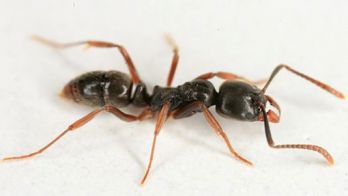Asian needle ant
The Asian needle ant, Brachyponera chinensis, is an invasive species of interest due to its:
- ecological impacts on biodiversity
- medical risks to human health, via sting-induced anaphylaxis.
Background
The Asian needle ant is native to Japan and is also found in China. It has spread to New Zealand, Cambodia, Philippines, Taiwan, Thailand, Vietnam and Republic of Korea.
The Asian needle ant has been in the U.S. since the 1930s, but their population has exploded in the past 10 years.
Until 2014, the species was also known as Pachycondyla chinensis.
Impacts
Asian needle ants cause a strong decline in native ant abundance. They disrupt ant-seed dispersal mutualisms by displacing native keystone ant species.
Asian needle ants feed on dead insects, fish scraps, and decaying fruit. They prey on live arthropods, especially termites.
Identification
Asian needle ants are a dark brownish-black colour, with orange-brown mandibles, legs, antennae, and stingers.
Workers are 3.4 to 5.0 mm in length, while queens are significantly larger at 5.0 to 6.0 mm in length.
Workers are wingless, while queens and males have wings, although queens lose their wings after mating. These ants have one large petiole, large compound eyes, and a well-defined stinger.
Their head is long, and their pronotum and mesonotum are convex in profile. Their head, pronotum, coxae, tibia, and gaster are covered in light, yellowish hair that gives them a bronze lustre.
Behaviour
The Asian needle ant’s distinctive walk is a giveaway of its identity. While some ant species lift their legs high and prance around, or stomp their way to and from their nests, Asian needle ants hunker down close to the ground and creep with deliberate, stealthy steps.
Most invasive ants use mass recruitment via trail pheromones to collect food, but no trail pheromones have been detected in the Asian needle ant.
Instead, they employ a slow process called tandem carrying, whereby foraging workers carry nestmates from the nest to the food source which is subsequently retrieved.
Habitat
Unlike colonies of ants that dominate urbanised and disturbed areas, Asian needle ants have the unique ability to invade natural habitats. They are commonly found in:
- forests
- agricultural land
- urban and suburban areas, such as parks and backyards.
Asian needle ants prefer nesting in dark, damp areas in soil beneath stones, logs, stumps, and debris.

